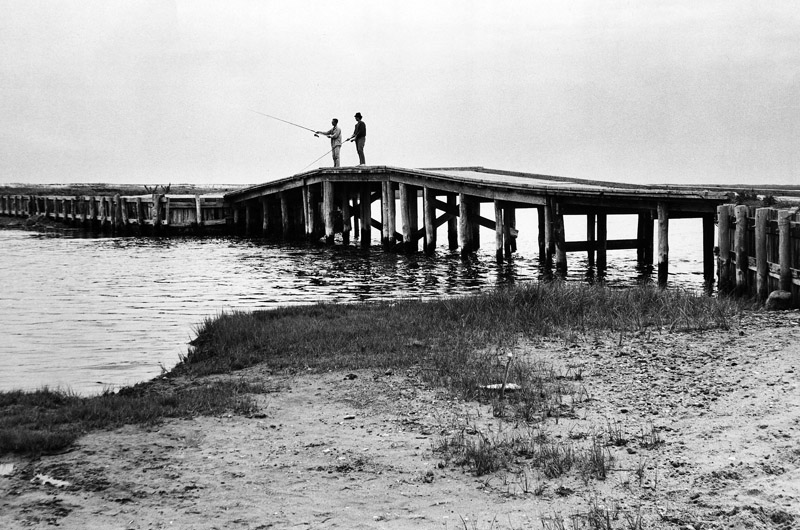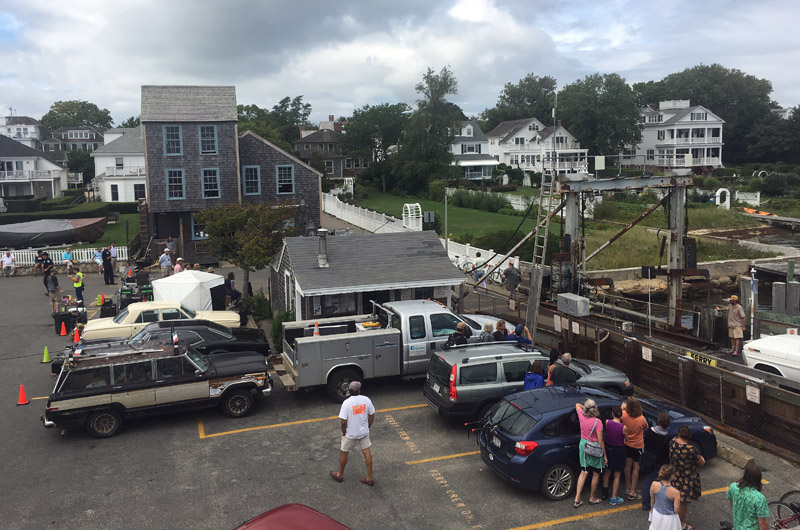A few years ago director John Curran and actor Jason Clarke made a late night trip to the Dike Bridge on Chappaquiddick. The bridge has been rebuilt, but the dirt road, Poucha Pond, and rural landscape haven’t changed much in 49 years since Sen. Ted Kennedy drove his car off the bridge in a late night accident that killed a young woman, Mary Jo Kopechne.
“We went out one night late to the bridge and looked around, 10:30, 11 o’clock, and just stood on it,” Mr. Curran said in a phone interview this week. “The thing that struck both of us was how incredibly dark it is. There’s no ambient light out there, and you really could imagine late at night, a car going into a pond and being disoriented. What really struck us was how disorienting and scary that must have been.”
“And you know, feeling the sort of ghosts of the story out there.”
Mr. Curran’s new film, Chappaquiddick, revisits what happened on the bridge during the July weekend in 1969 and the investigation, media maelstrom, and Kennedy family crisis that followed. The film will premiere on the Vineyard on Thursday, March 15 for the opening night of the 2018 Martha’s Vineyard Film Festival. A discussion with Mr. Curran and Mr. Clarke, who portrays Mr. Kennedy in the film, will follow.
It also shows March 17 as part of the festival. It is scheduled for wide release on April 6.
“I feel kind of proud and pleased that we’re kind of premiering this film out there,” Mr. Curran said. “There’s a sort of poetic justice to it all...I’m looking forward to showing it out there and getting a reaction.”
Mr. Curran said he was drawn to Chappaquiddick because of the script by Taylor Allen and Andrew Logan. He had vague memories of the incident, which took place when he was nine years old, and is a Ted Kennedy fan in terms of his legislative record, he said. He found the movie “kind of very confronting.”
“We all felt that we were drilling into a chapter in American history that we felt was well deserved to take a look at,” he added.
Most of the details were drawn from an inquest into the incident — an unabridged transcript is kept at the Edgartown courthouse. “It wasn’t just a one dimensional sort of hit piece,” Mr. Curran said. “We’re trying to present a fuller picture of the incident as it was.”
The film steps back to show what was happening during that weekend in July 1969. Apollo 11 had just launched, headed for a moon landing. The Edgartown Yacht Club’s annual regatta took place, in which Mr. Kennedy sailed the Wianno sloop Victura. Former staffers for Bobby Kennedy’s presidential campaign gathered for a reunion, including a Friday night party at the Lawrence Cottage on Chappaquiddick.
By 17 minutes into the movie the infamous event has taken place: Mr. Kennedy makes the sharp turn off the paved road that leads to the Chappy ferry and down the dirt road toward the Dike Bridge. The car goes off the bridge, landing in Poucha Pond.
The story is familiar to those versed in Vineyard or American political history, from Mr. Kennedy’s failure to immediately report the incident to the discovery of Ms. Kopechne’s body in the car the next day.
The events have been subject to years of speculation and alternate theories. Mr. Curran said the film tries to hew to what can be known of that night.
“The writers had done a really well-researched job of constructing the narrative based on the facts on hand,” he said. “Obviously we’re creating dialogue and some hybrid characters, but what I didn’t want to do was inject it with our own sensationalistic ideas about what actually went down. The part between him and Mary Jo, nobody knows except those two people. I felt it was important to try to try to tell the most truthful story possible and leave other ideas open to interpretation, if not borne out of fact.”
Kate Mara portrays Mary Jo Kopechne, who was 28 and had worked on Robert Kennedy’s presidential campaign as one of the “boiler room girls” who gathered that weekend for a reunion. Reeling from the assassination of Robert Kennedy, Ms. Kopechne was working on a Jersey City, N.J. mayoral campaign at the time of her death.
Mr. Curran said he aimed to make her a fully dimensional character. “She does get relegated to a minor footnote at times in this story...when you read about it, she’s sort of one-dimensionally portrayed as a secretary. The fact is all the boiler room girls, they were highly educated, ambitious, intelligent and accomplished,” he said. “I wanted to try to create a portrait of her that was more authentic of the real Mary Jo, someone that was very thoughtful and professional and very loyal to the Kennedy family.”
The movies also draws back to look at Ted Kennedy during that time in his life. He was 37 years old, still mourning the death of Robert Kennedy, his only living brother, and bearing the weight of high expectations. During one early scene, a family friend toasts “To Ted and the White House in ‘72.”
“The younger generations now don’t even know Ted Kennedy, necessarily, or this chapter in his life, and I felt it was very important to the story that you understood who he was, what the expectations were upon him at that time in his life,” Mr. Curran said.
Mr. Curran comes from a large Irish Catholic family with a lot of boys. “I certainly related, or tried to relate, to the idea of the youngest brother being the last alive, after all his brothers had died in the line of service,” he said. “I felt the film presented a fuller picture of Ted at that time in his life, and what he was going through, and then sort of informed the decisions, right or wrong, that were made after the accident.”
Bruce Dern portrays the mercurial family patriarch, Joseph Kennedy Sr., wheelchair bound and partially paralyzed after a stroke. Mr. Curran joined the project after Mr. Clarke had been cast as Ted Kennedy.
“These are hard films to do, with well known people who are iconic,” Mr. Curran said. “It’s hard to cast a major movie star, and then believe them in these roles...the Kennedys were very distinct in the way they looked and the way they talked. I did feel that Jason physically resembled Ted and in talking to him, his idea wasn’t to do a caricature of Ted or an impression of Ted, it was to create something wholly authentic and unique.”
To understand Mr. Kennedy’s mindset in the summer of 1969, Mr. Curran and others plumbed books, interviews and anecdotal information about the family in 1968 and 1969. Mr. Curran said he came to understand Mr. Kennedy at that time as a grieving brother. “I felt that by all accounts there was a sadness in him, a depression, that he masked when he had to professionally, but in private, people could see that there was an existential heaviness and weight in him.”
Mr. Curran and his crew also revisited Martha’s Vineyard in the late 1960s, recreating the Shiretown Inn on North Water street, where Mr. Kennedy stayed, Edgartown town hall, and of course the Dike Bridge. Vineyard figures from the ‘60s are portrayed, from the medical examiners to the local prosecutor and judge, Walter Steele. Current Chappy ferry captain Caleb Enos portrays a ferry deckhand and captain Rick Hamilton plays a ferry captain. James (Scotty) Reston, a New York Times reporter and then owner of the Gazette, runs into Mr. Kennedy outside Edgartown town hall, and later casts suspicion on the senator’s concussion diagnosis.
Some filming took place on the Vineyard, including on Chappaquiddick and at the Chappy ferry, made to look as it did in 1969. The movie was otherwise filmed outside of Boston and in Mexico.
“I wanted to have a sense of Martha’s Vineyard, the real Martha’s Vineyard, and also because there’s such a geographical specificity to so many of the locations of the story: the intersection, the dirt road to the bridge, the Dike House. It was so specific, instead of recreating it, I wanted to feel it in the film,” Mr. Curran said.
He said he felt welcomed on the Vineyard. “Everybody was incredibly accommodating, and amazingly helpful. It’s so far in the past now,” he said. “If we tried to make this film, lets say in the ‘70s and ‘80s, Martha’s Vineyard would have been sick of us by then...from talking to locals, I think they got kind of sick of it after awhile.”
Mr. Curran said he hasn’t heard from members of the Kennedy family or any other people portrayed in the film, except for one. By coincidence the daughter of former Edgartown police chief Dominic Arena, who plays an important part in the film, was visiting Edgartown on the day the crew was filming there. She connected Mr. Curran to her father and they talked on the phone.
The director acknowledged that the movie is inherently divisive. “We’re trying to make a human drama...but ultimately it becomes politicized,” he said. “Everybody views the story through a different prism. If you’re a Ted Kennedy fan you have a certain opinion about what went down, if you don’t like Ted Kennedy, you have a very different view, and we heard both sides. We really tried to make a film that was non-partisan...that was right down the middle where it wasn’t trying to lean one way or another. Just trying to tell it very truthfully and honestly.”
Audiences who have seen the film so far were almost split down the middle between those who thought the movie was too sympathetic to Mr. Kennedy and those who thought it wasn’t sympathetic enough, he said. “It’s amazing how a group of people can see a film like this and have wildly different interpretations.”










Comments (11)
Comments
Comment policy »